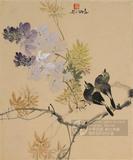明林良畫鷹 軸
推薦分享
資源連結
連結到原始資料 (您即將開啟新視窗離開本站)後設資料
- 資料識別:
- 故畫000426N000000000
- 資料類型:
- 類型:繪畫
- 型式:靜態圖像
- 著作者:
- 林良
- 主題與關鍵字:
- 鷹
- 出版者:
- 數位化執行單位:國立故宮博物院
- 格式:
- 本幅 133.4x80.5公分、全幅 106.1公分
- 關聯:
- 石渠寶笈初編(養心殿),上冊,頁660&*故宮書畫錄(卷五),第三冊,頁309&*故宮書畫圖錄,第六冊,頁339-340&*1.〈明林良畫鷹圖〉,收入陳階晉、賴毓芝主編,《追索浙派》(臺北:國立故宮博物院,2008年初版一刷),頁176-177。 &* 林良(活動於西元十五世紀後半),廣東南海人,字以善。明英宗天順年間(西元一四五七-一四六三年)供奉內廷。工花鳥,特善水墨作畫,時將草書之法融於畫中。 兩鷹卓立,筆墨豪放,而有磅礡之氣勢。樹木枝葉用筆剽疾,有飛舞使轉之意,畫史所謂林良以草書入畫,即指此等。 &*Two Eagles Lin Liang (active 1457-1463) Ming Dynasty Lin Liang, style name I-shan, a native of Nan-hai in Kwangtung Province, served as a court painter during the reign of T’ien-shun (1457-1463), Best known for his monochromatic paintings of birds and flowers, he skillfully employed the brush methods of cursive calligraphy in his ink paintings. Two eagles standing alone are described with vigorous, unrestrained brushwork which vividly captures their fierce character. The sinuous lines, describing the branches and leaves, evidence rapid movements of the brush. This type of brushwork resembles cursive script, a highly abbreviated and fluid style of calligraphy admired for its beauty and expressiveness. Hence, the statement in traditional Chinese histories that Lin Liang used the techniques of cursive style in painting may well refer to the type of brushwork seen in this scroll.
- 管理權:
- 國立故宮博物院
授權聯絡窗口
- 國立故宮博物院圖像授權、出版授權、影音資料授權-申請流程說明
http://www.npm.gov.tw/zh-TW/Article.aspx?sNo=03003061






